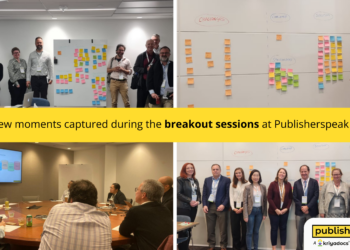
(Please be aware, this article was posted on April 1st)
A sense of gloom hangs over academic publishing these days. As library budgets are cut, and the fear of OA mandates cutting profit margins clouds publishers’ sense of their place in the world, what is it like to be a publishing professional in this era of climate change? Like polar bears on a melting ice floe, will we soon be adrift in an inhospitable ocean?
A recent study by the Institute of Publishing Professionals reports that morale among senior executives in the publishing industry is at an all-time low. The study, performed internationally and focusing mainly on the private sector, shows record numbers of editorial moving to jobs outside the field, with jobs in realty being the number one choice.
“I am eminently qualified to sell houses”, one senior publisher revealed (on the basis that he remain anonymous). “My skillsets of not knowing much about anything, being able to win hearts and cut deals through obfuscation and charm over a good dinner, are ideal for closing the sale”, he said. “There is a place for those of us with a conservative outlook, who know how to maximize profit margins and still keep sometimes belligerent customers happy”. One downside is their inability to let poor copy for ads pass unscrutinized. “I found myself obsessing over whether ‘mancave’ was appropriately spelled as one word or two,” claimed one.
Another area that appears to be booming in the face of a publishing brain drain is psychotherapy. Publisher skills of dealing with cranky authors and finicky academics come in handy here, too. “My ability to nod knowingly and sympathetically at appropriate intervals has come in immensely handy.” Moreover, former publishing contacts form a natural client base. “Frankly, I was amazed when I suddenly realized that my patient had a similar background in brand marketing in academic publishing as I had. In fact, we further found out that we were connected on LinkedIn”.
The report concludes by taking comfort in the fact that while publishing professionals are jumping ship from the industry that has looked after them for centuries, there is a home for them still in other parts of corporate life where profit margins still matter. And when all else fails, used car sales beckon as a potential growth area.
Discussion
11 Thoughts on "Publish or Perish: Is Publishing the Career it Once Was?"
Sources are somewhat split on an important question raised by this post.
While some slang sites consider “mancave” to be one word, the official Man Cave website (http://www.mancavesite.org/) uses the two word variant.
In such important matters, though, it is best to defer to an appropriately authoritative source: http://en.wikipedia.org/wiki/Man_cave
Yes, I had to look this up…
This sad report follows on the heels of the more empirically devastating graph of decreasing library allocations shown by Phil Davis in a previous Scholarly Kitchen post (see below). One question for journal publishers, if they are to expand both hybrid and pure Open Access journals, is how to compete effectively for OA slices of research funds both a few giant sources combined with individual grants spread out enormously. Alternatively the task of procuring article processing fees from hundreds of thousands of individual academics (as opposed to selling Big Deals to just a few hundred libraries) is even more daunting. It seems as challenging as selective journal “page charges” were and are: these were never “sold. ” They were only gingerly and gratefully “received.”
Is the “natural appeal” of journals with high impact score attractive enough to bring in sufficient income from OA sources? Or is there sufficient attractiveness involved with the ever-more frequent rush to early “flash publishing” of author papers? I.e., the earlier the better? This includes the recent noted trend of selling the author’s submitted and editorially approved manuscripts in Microsoft Word format as individual articles, as well as part of individual and institutional subscriptions.
Possibly even more unwelcome whipped on the sagging cake, Jeffrey Beall reports that the number of new’ ‘predatory’ Open Access journals is increasing by the hundreds every several weeks (private communication).
If some librarians privately (and understandably) welcome this trend after years of economic pressure and trauma, they too may find that they may have to seek alternative careers. The old saw comes home to roost: be careful what you wish for.
Does anyone see solutions to what must ultimately be termed a ghastly “disruption” in our
industry’s once-brilliant sparkle?
Bill Cohen
http://scholarlykitchen.sspnet.org/2012/02/15/a-shrinking-piece-of-the-university-pie/
I found this very funny until I remembered I’ve recently completed a course to be a Certified Mediator. Also, you forgot high-speed taxi driver, judging by the skillset of many of my colleagues.
I think academic publishers would be wise to consider switching to the business of catching and selling lionfish. Much like OA, this invader is rather thorny and is gobbling up the native species, but unlike OA publishers, you can you can fry and baste the fish to serve up a tasty treat (http://www.foodandwine.com/articles/lionfish-invasion-a-guide-to-hunting-and-fishing). What better way to exact revenge and even make a living off it…
On a more serious note. The academics control the purse strings. They say what is bought. I would hate to be the person who tells the Chemistry Department faculty that they can no longer receive JACS!
Thus, quality sells and will continue to sell. Notice that Neiman Marcus did not suffer throughout the recession,
OA will grow to a point and then no further. What will happen when new or young faculty are hit with a $5K price tag to publish an article?
It can be argued that the gate keepers were preventing exciting research from being published but that is put to bed when one sees the results of “unreviewed reviewed” articles hitting the shelves. At a given point a number of the OA journals will be viewed as publishing drivel and the gate keepers – those who grant tenure – will apply the brakes. In short, IF will become more of a yard stick rather than less of one.
Lastly, I remember a young editor presenting a book to Mr. Jerry Kaplan – founder of the Free Press and President of Macmillan Pub Co, who upon looking over the proposal and noting the author said: You cannot make a silk purse out of a sows ear! Quality sells not necessarily quantity or price.
Heh. Not quite as amusing for manuscript editors, though: I’m aware of one joint that pays a Lincoln per typeset page and mainly supplies heavy-duty EFL copy. That’s $2 or $3 an hour for the promised level of edit.
Nor, I suppose, for entry-level folks and those of us who did multi-year unpaid internships; the fact that so many people (with graduate degrees and other qualifications) are applying for editorial/marketing assistant jobs in New York/DC/Boston – in excess of 200 for any one opening – for positions that might pay $32k a year isn’t encouraging. The days when you could walk out of your soul-crushing PhD program and into an editorial assistant position as many more senior people seem to have done are very much over.


